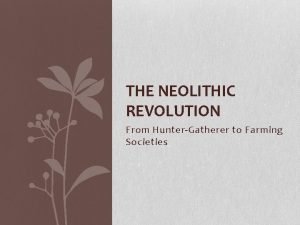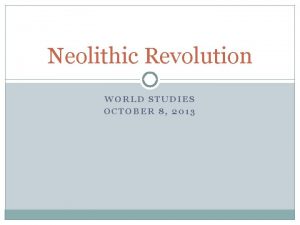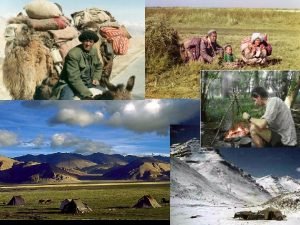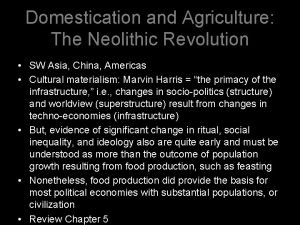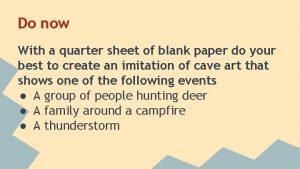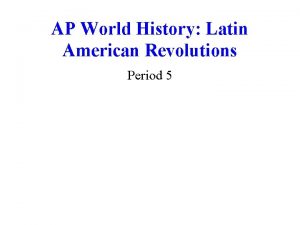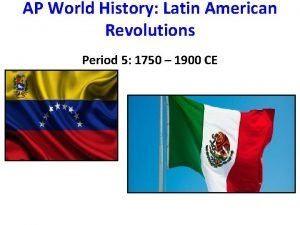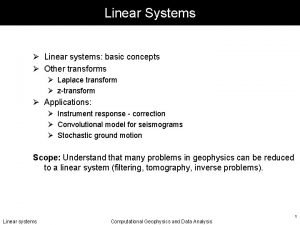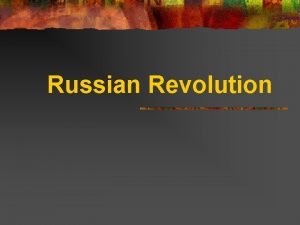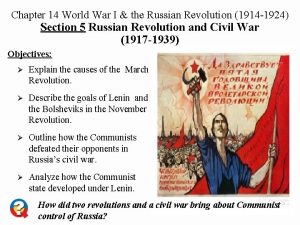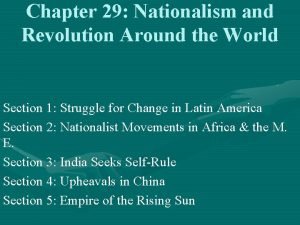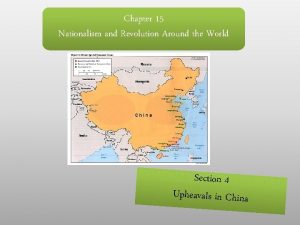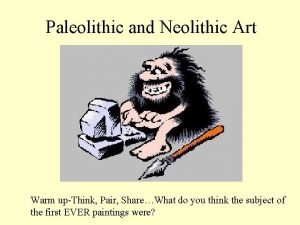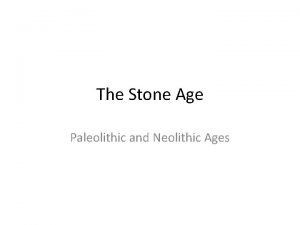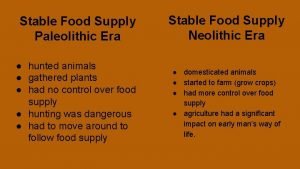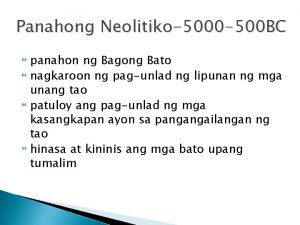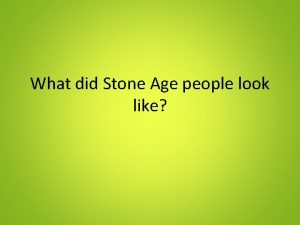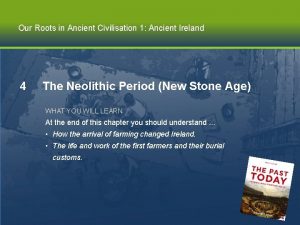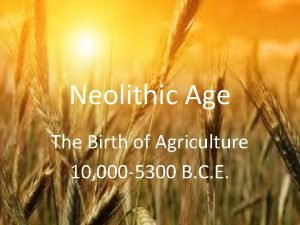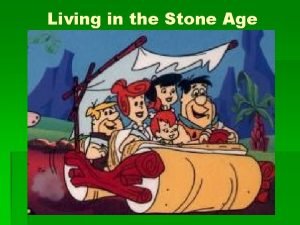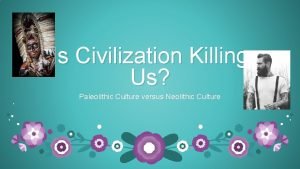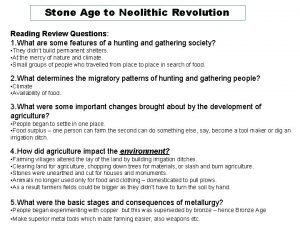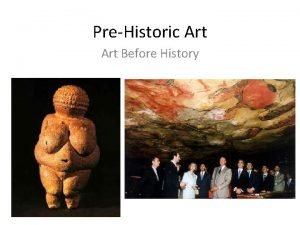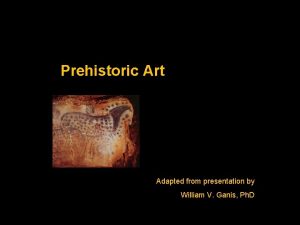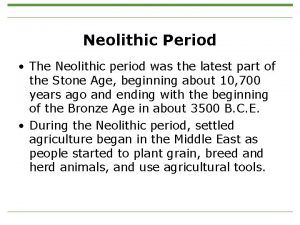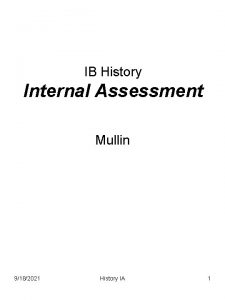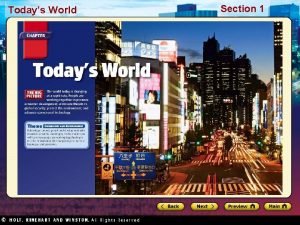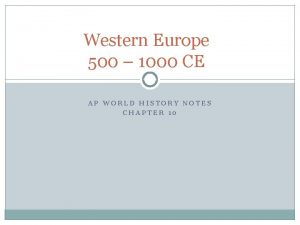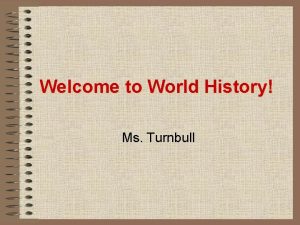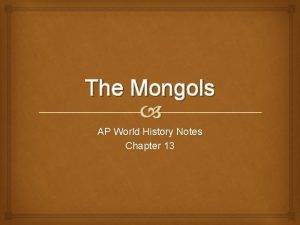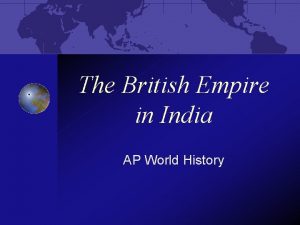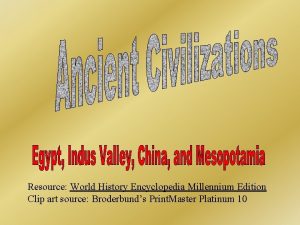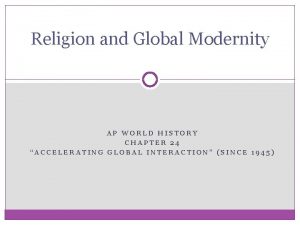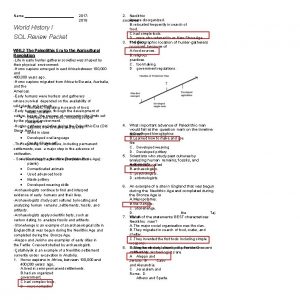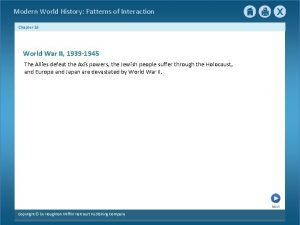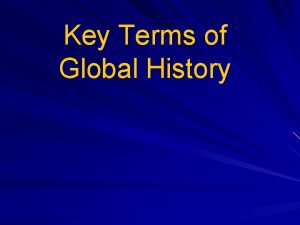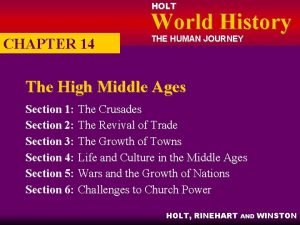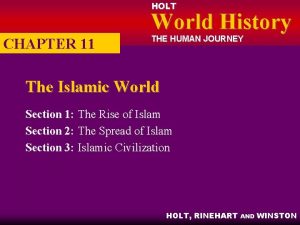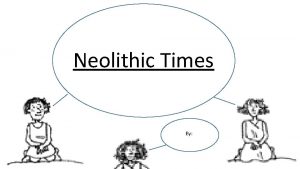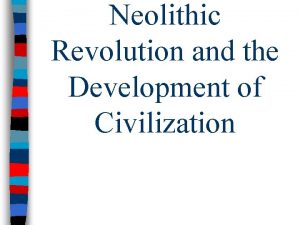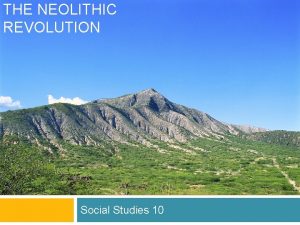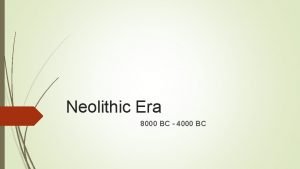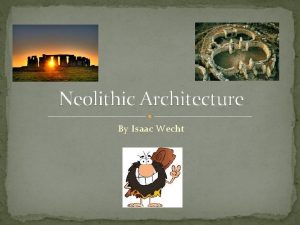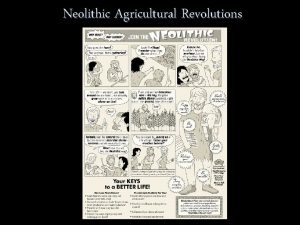Domain I World History PART 1 Neolithic Revolution














































































































- Slides: 110

Domain I: World History PART 1




Neolithic Revolution: Development of Agriculture Learn more about the Neolithic Revolution. (10 th grade TEKS covered 1 A, 2 A, B, C, 16 A): Origins of Agriculture The development of agriculture is considered one of the most, if not the most significant technological developments in all of human history. It started about 12, 000 years ago. There are still a handful of hunter/gatherers, but its more the exception now, most rely on settled agriculture. Agriculture gave humans control. They could control the growth cycle and made them responsible for the domestication of plants and animals. Those who plant must sow seeds at the right time, protect the plants, harvest on time and safely store them, saving enough seed for the next season. It was a complicated process. There is evidence that women started the cultivation of plants as they became more and more familiar with the cycles of them. Those who raise animals must protect them against predators and provide food for them. These techniques developed independently in different parts of the world but at around the same time about 10, 000 years ago. That shift to practicing fully settled agriculture is the period we call the Neolithic. Producers of stone flake tools began turning them into harvest tools. The tools are different for farmers versus hunter/gatherers. Farming first originated in SW Asia, the Fertile Crescent. Other areas include: China, New Guinea, sub-Saharan Africa, Mesoamerica, the Andes and eastern North America.

Neolithic Revolution: Development of Agriculture Learn more about the Neolithic Revolution. (10 th grade TEKS covered 1 A, 2 A, B, C, 16 A): Fertile Crescent The region of Southwest Asia with rich natural resources arching along the Mediterranean coast and modern southern Turkey and eastern Iraq is known as the Fertile Crescent. The switch to agriculture was probably more of a transition than a revolution. Around 10, 000 BC it was covered with fields of wild wheat and barley and inhabited by wild sheep, goats, pigs and cattle. These are what humans first learned to cultivate Its argued that they favored wild strains that were easier to manage and harvest and they chose grains because of what they could do for them. Also, its argued that women worked with the agriculture, while men dealt with the animals. They argue men protected the animals they wished to domesticate and altered the sex ratio to keep them in place. As they kept them in one place they became smaller. They evolved in different ways as well, becoming smaller or more hairy if the climate was colder. Animals were used for food, textiles, milk products and skins, bones, horns, hoofs and sinews could be used for utensils and other items. They learned to use them as tools. They founded new uses for everything. At the end of the last Ice Age, the earth's climate got warmer and food supplies were reduced. As groups in the fertile crescent grew more food in new areas to make up for the losses, that knowledge spread and more groups began doing that. The earliest areas are in Turkey and Europe. Humans began intensive irrigation to force water into areas not well watered. The thing is agriculture is more difficult and more risky. Farmers were more vulnerable to epidemic diseases because they lived more closely together. The big advantages were that they produced more food from domesticated than wild plants. Farmers could live in larger communities than foragers. Increased permanence of agricultural communities led to expanded social interactions and better survival for newborns.

Neolithic Revolution: Development of Agriculture Learn more about the Neolithic Revolution. (10 th grade TEKS covered 1 A, 2 A, B, C, 16 A): Neolithic Tools Housing changed. First they were circular, then rectangular with rooms. New notions of family for example and a sense of permanence were important. There were more sophisticated tools now. Mortars and grinding stones were the best ones, to turn grain into flour. They also probably cooked the gruel or mash from the flour. This became gendered we believe, with women doing most of the work. Also bread and beer became more and more significant. Both are grains mixed with water and used in different ways. Clay was used for figurines and then used to create pots for cooking and storing food. This allowed farmers to build upon the advantages of settled agriculture. They were easily produced from local sources in all shapes and sizes. They were safe for grains and protected against pests and moisture. They could be used to cook also. The earliest metal used was copper. It was hammered cold but heated to extract pure copper later and pour it in liquid to form molds. They expanded this to use with other metals to make stronger things, like bronze, copper and tin. People learned to twist materials to make textiles. They did this to make clothing, blankets and other fabrics. Some came from the domesticated animals like sheep or goats, others were plants grown or that purpose like flax. The earliest dates to 6500 BC. Most of these innovations have been attributed to women.

Neolithic Revolution: Development of Agriculture Learn more about the Neolithic Revolution. (10 th grade TEKS covered 1 A, 2 A, B, C, 16 A): Neolithic Life As people settled down and population numbers grew, a social inequality developed. Before people could not accumulate much, but now they could and those that had more were higher in status. The only difference appears to be in terms of reverence. Many of the sites have Venus figurines. These seem to have been created for fertility rites as they appear to highlight aspects of female reproduction. Some scholars argue about there being a mother goddesses or something similar. There is also evidence of a matrilineal line of descent. However only at Banpo, the Neolithic site in China, do we see evidence of real matriarchy though.


Mesopotamia translates as “the land between the rivers”, the Tigris and Euphrates Rivers. A collection of city-states emerged in this region as the size of the population grew due to an increase in agriculture. These rivers flood irratically, but provided the water needed for irrigation. In this region the Sumerians developed the first large cities, like Jericho. They also developed writing, large buildings, used wheeled technology, and bronze. They engaged in trade with other city-states as they developed in the region as well. As the population grew there was no longer a need for all to engage in farming, so labor diversified. Some became rulers, others merchants or artisans, and still others, religious leader. Religious life in Mesopotamia was based on nature gods, a polytheism (with multiple dieties). They constructed temples known as ziggurats. They also created writing in the form of cuneiform. This involved taking pictographs and including special signs to convey the meaning of more abstract ideas or tenses. These are called conventional signs. The developed a system of laws, one known as Hammurabi’s Law Code and developed a theocracy first with a king, but later the king became more politically powerful.

Egypt Early civilizations in Africa centered around the Nile River. The Nile has a regular pattern of flooding and therefore was predictable. By 5000 BC the first civilizations developed here. It was also only unified gradually under a series of villages. Around 3100 BC, the area became ruled by a Pharaoh, a god in human form. The government was organized and run by officials that included land owners and religious leaders, however, the pharaoh was ultimately responsible for the wellbeing of the people. Egypt’s history is also divided into dynasties such as Old Kingdom (3100 -2200 BC), Middle Kingdom (21001650 BC) and New Kingdom (1500 -700 BC). These correspond with political stability and the control the pharaoh had. Various cultural achievements include a form of writing in hieroglyphics which were pictographs. They represented sounds and/or nouns. The religion was also a form of polytheism with multiple deities. They took the afterlife very seriously and were known for the creation of pyramids, especially the ones at Giza. Again, the population grew in this area of abundant and predictable access to water and allowed the labor to diversify. Other groups in the area, such as Nubia, conducted trade with Egypt.

China’s earliest civilizations developed in the north around the Yellow River. The Yellow River is like the Tigris and Euphrates in its unpredictability. It is filled with silt which gives it the yellow color. The land around it contains loess soil, highly fertile soil that will produce crops with minimal water. Therefore the population grew and expanded as in other areas. The earliest Neolithic site is Banpo. We know this area began the development of settled agriculture here and used pottery to store excess food. Legend tells of three kings who brought to China sericulture, agriculture, and the ability to control the Yellow River. Therefore, key parts of the mythology focus around controlling the river. It has jumped its course 26 times in recorded history. These early rulers are still part of the legendary Xia Period. This period, it is written, had kings who governed over a network of villages, but in a decentralized way. It was an early form of feudalism. The Shang Period, that emerges after the Xia, expands upon this feudalism and is documented through oracle bones, bones inscribed with Chinese text. The form of writing was also pictographic here, but these bones contained questions and demonstrate the authority of the king and priest. The religion focused on Tian or Heaven, who would answer questions and provide political legitimacy for a ruler.

India’s civilization is also known as the Indus Valley civilization, and grew out of an area where the Indus and Saraswati Rivers meet. Again, the population grew due to increased agricultural production. Between 6000 and 4000 BC, the region had a much denser population than the other areas. Groups in this area also had to deal with erratic flooding. More than the other groups, however, trade was a key part of the economy. The two key sites are Mohenjo-Daro and Harappa. Each of these probably housed at least 100, 000 people. It also was ruled under a theocracy, where priests ruled as the representatives of the gods. They had large buildings and temples and indoor plumbing, so they were technologically advanced. These two areas were invaded by Aryans, groups who came in and recorded their domination of the peoples of India in the Vedas, oral traditions that were written down much later. The Aryans were horse-breeding people of Central Asia, further to the north. These Vedas record that history and the development of the caste system, a social system that placed all individuals into a caste that determined their position and role in society. The highest role was that of Brahmin, the priestly caste. The religion was very strict and full of rituals and is known as an early form of Hinduism.

Phoenicians, Hittites, Assyrians, Babylonians, Hebrews The Sumer civilization influenced the development of others in the region. The Phoenicians are known for the alphabet. They were the inhabitants of important port cities and were known for being a hub of trade. They were famous also for their craftwork. The Hittites were Indo. European migrants to Mesopotamia. They migrated around 1900 BC and imposed their language on the people around them and their rule. They built a powerful kingdom and established a close relationship with those around them. They traded with Babylon and Assyria, adapted cuneiform to their language and accepted many of the deities in the area. In 1595 BC they toppled the Babylonians. Between 1450 and 1200 their authority extended down to Syria and Phoenicia. They are known from iron production and the horse drawn chariot. The Assyrians were in northern Mesopotamia at about the same time, 1900 BC. They began to militarily dominate the region in 860 BC. The king was the head of the military. The military engaged in expansion. They were only strong when they had a strong military leader. Babylon was more to the south and controlled those areas in the 1700 s BC. Babylon is known for Hammurabi’s Law Code and King Nebuchadnezzar. The Hebrews lived between Mesopotamia and Egypt. Abraham lived in the Sumer city of Ur. Their story speaks of a flood. They also migrated to Egypt for a time and developed a monotheism known as Judaism.

Shang and Zhou China The mythical Xia period involved kings that governed in a feudalistic way over surrounding villages. One such king was said to have tamed the Yellow River and was given bronze tripod in gratitude by those villages. The Shang Period has been documented by oracle bones. These bones were inscribed with Chinese characters and then broken by fire, by a priest, to read the answer. This was a form of divination. The justification for the Shang replacing the Xia, lies in a concept known as the Mandate of Heaven. The idea was that elements of life that humans cannot control are controlled by heaven. Therefore when a king witnessed famine or flooding, these were signs to the people to replace them. The kings worked hard to ensure they would have the mandate early in the period. Later kings would not and signs would appear that the mandate had been taken away. The Zhou, operating a regional domain to the west of the Shang leadership, took over around 1100. They justified their control based on the tyranny they recorded of the last Shang king. They further developed concepts such as the mandate of heaven and controlling the yellow river and maintaining a granary became key in keeping it. The Shang Period was also known for its bronze which is further developed during the Zhou. The Zhou Period does get divided into two halves. The Western Zhou being stronger than the Eastern Zhou. The Period of Warring States sees the end of the Zhou.



Religions and Philosophies of Classical Civilizations Read below to learn more about the religions associated with classical civilizations 500 BC to 600 AD. (10 th grade TEKS covered 1 B, 3 A, 22 A, B, 24 A, B, 25 A) India: Hinduism honors many gods and goddesses, but the two key ones are Shiva and Vishnu represents the northern Aryan peoples and Shiva represents the southern or Dravidian peoples. Vishnu was a benevolent god who preserved and protected the universe. Shiva was warlike and present in places of disaster. Vishnu could appear in numerous incarnations which linked him to the gods and heroes of other traditions. He could be Krishna warrior god and shepherd. This flexibility was a key consequence of the Vedic tradition's evolution into Hinduism. One of its strengths was its ability to incorporate elements from many religious traditions and to thrive in diverse communities across India. The Hindu way of life encouraged a balanced pursuit of devotion and pleasure. People should seek righteousness, virtue and duty. Correct balance among these would lead to liberation from worldly life. The poem Bhagavad Gita "Song of the Lord" explains how a person could attain this balance. It was seen as strict and supported the caste system. With concepts such as reincarnation, one could move up.

Religions and Philosophies of Classical Civilizations Read below to learn more about the religions associated with classical civilizations 500 BC to 600 AD. (10 th grade TEKS covered 1 B, 3 A, 22 A, B, 24 A, B, 25 A) China: Confucianism, Daoism, and Legalism Confucianism was a philosophy born out of the period of the Warring States and the end of the Zhou Period. This was a time of great chaos and suffering. Confucius was like many philosophers at the time, trying to come up with a philosophy for the government and society that would alleviate the warfare and suffering. He sought to advise kings in the warring states to adopt his ideas. Confucianism is based on the 5 relationships. The general idea is that if one acts according to their place within these relationships, there will be harmony. The relationships are ruler to subject, father to son, elder brother to younger brother, husband to wife, and between friends. These were also supposed to be reciprocal, so a ruler must act benevolently so the subject will follow him. All dynasties, after the Han, adopt Confucianism as the basis for their bureaucracy. Other philosophies included Legalism and Daoism emphasizes nature as a guide for human behavior and legalism emphasizes the need for strict laws and punishments in order to bring about peace.

Religions and Philosophies of Classical Civilizations Read below to learn more about the religions associated with classical civilizations 500 BC to 600 AD. (10 th grade TEKS covered 1 B, 3 A, 22 A, B, 24 A, B, 25 A) Israel: Judaism and Christianity The basis for Judaism is found in the Old Testament and focuses on Judea and the Hebrew groups of the area around Israel. The tradition holds that Abraham lead his people out of a wilderness to Canaan and is verified in documents. The exodus from Egypt later under Moses is also in documents and marked a return to Canaan. Key leaders included David and his son Solomon. At one point an alliance between Judea and Samaria existed, but that ended in 722 BC. They found themselves in captivity to the Babylonians from 586 -539 BC. After Cyrus of Persia released them some returned. It was in this period that Judaism took on a strict monotheism. Discussions of a messiah who would return to save and reestablish them flourished. Christianity was born out of this belief in the first century through the story of Jesus of Nazareth. Followers believe he is part of the trinity, the three facets of the one true God that has and will intervene on behalf of his followers. Both Judaism and Christianity are major world religions, that have had a significant impact.

Religions and Philosophies of Classical Civilizations Read below to learn more about the religions associated with classical civilizations 500 BC to 600 AD. (10 th grade TEKS covered 1 B, 3 A, 22 A, B, 24 A, B, 25 A) Persia: Zoroastrianism The earliest Persian cults were based on natural elements, the sun, moon, water and especially fire. They tended to glorify strength and virtues in war and sought to bring about a comfortable material existence for followers. Zarathustra, the founder, was a real person. Moral and religious thinkers sought to adapt their messages to the new circumstance of a complex cosmopolitan society. Little remains of Zarathustra's life, he lived probably in the late 7 th to early 6 th century BC. He was probably from an upper class family and a priest. He became convinced that the supreme god, Ahura Mazda or "wise lord" had chosen him to serve as his prophet and spread his message. Mazda was the supreme being but there were 6 lesser deities. There was an enemy Angra and after a 12, 000 year battle, Mazda would be victorious and reward followers. The Magi, his followers wrote things down. The Avesta became the key text, but was written much later. The Gathas were hymns written down and composed for various deities in the pantheon. The takeover by Islam dropped the number of followers.

Religions and Philosophies of Classical Civilizations Read below to learn more about the religions associated with classical civilizations 500 BC to 600 AD. (10 th grade TEKS covered 1 B, 3 A, 22 A, B, 24 A, B, 25 A) India: Jainism was also born out of the rejection of the caste system of India. It was a strict religion that was based on the belief that everything that had life needed to be protected. Jainism became popular because of Vardhamana Mahavira in the 6 th century. He left home at the age of 30 to seek salvation by escaping reincarnation. For 12 years he led a life wandering throughout the Ganges valley in which he gained enlightenment. He abandoned all his worldly goods, even his clothes and taught a doctrine of detachment from the world. For the next 30 years until his death about 468 BC he preached his thought to a group of dedicated disciples who formed a monastic order to spread his message and keep it alive. They referred to Mahavira as Jina or the conqueror and borrowing from that title called themselves Jains. A lot of the inspiration came from the Upanishads. They believed that everything in the universe possessed a soul, even inanimate objects. One could achieve relief from suffering if they followed Jain ethics and it applied to all, regardless of caste.

India: Vedic Era 1500 -500 BC Read below to learn more about Classical India. (10 th grade TEKS covered 1 B, 3 A, 22 A, B, 24 A, 25 A, 26 A) The Vedic Age in India refers to the period after the Aryan invasion from the north. The priests of the Aryans passed down oral traditions through the Vedas. These were are collections of hymns, songs, prayers, and dialogues. Veda means "sacred knowledge" They were written in a very early form of Indo European Sanskrit language, but later. There are 4 Vedas, the oldest being the Rig Veda. They portray a society torn by violence, depicted the Aryans as light skinned nomadic warriors who conquered local dark skinned people, the Dasa or "enemy". The social structure that developed here relied heavily on family relationships. Extended family joined in clans. These developed into the caste system, a strict hierarchy in Indian society that was based initially on skin color. Originally the system had 4 levels, Brahmans or priests, Kshatriyas or warriors or aristocracy, Vaishya or landowning peasants or merchants, and Shudras the largest group of landless farmers, artisans, or laborers. The Untouchables would provide other distasteful services and the jati, subcastes, would accommodate more people.

India: Vedic Religion and Hinduism Read below to learn more about Classical India. (10 th grade TEKS covered 1 B, 3 A, 22 A, B, 24 A, 25 A, 26 A) The Vedas portray a rich religious system. There are gods and ideas that are found in other Indo European cultures. Male gods dominate the Vedic world. Their leader was Indra, the war god, often violent and drinks. He wielded the thunderbolt and protected the universe against demons. The sky god, Varuna, maintained cosmic order and justice. He punishes liars and those who do evil. The god of fire, Agni was the intermediary between humans and the gods. Fire made it possible for people to give sacrifices. Humans could communicate with the gods through rituals and sacrifice. Trained priests burned the offerings to urge the gods to be kind, they sang hymns and drank soma (drug) while doing so to have visions. Vedic religion kept the brahams at the top of the caste. The reinforcement of the caste system, led others to form other religious traditions and eventually Vedic religion evolved into Hinduism and while it contained elements of reincarnation, it upheld the caste system. Still other religions such as Buddhism and Jainism, provided more options to achieve enlightenment.

India: Buddhism Read below to learn more about Classical India. (10 th grade TEKS covered 1 B, 3 A, 22 A, B, 24 A, 25 A, 26 A) In the 6 th and 5 th centuries BC a rash of new religions and philosophies rejected the brahamins and appealed to the interests of a new social class. These turned to intense spirituality as an alternative to the mechanical rituals of the brahamins. The most signifcant for world history was Buddhism. Siddhartha Gautama is the founder. He was from an upper class family in Nepal. When he went out into society as an adult, he was shocked to see people aging and suffering. He began a quest to end suffering. After meditation under a tree, for 49 days, he achieved enlightenment. Part of the faith involves understanding the 4 noble truths of suffering and following the 8 fold path to enlightenment. He died in 483 and followers began compiling his words. Buddhism would expand become a significant world religion. It appealed to many as it rejected the caste system, but later provided a way to escape one's caste and enter a new one upon reincarnation.

India: Buddhism after Gautama Read below to learn more about Classical India. (10 th grade TEKS covered 1 B, 3 A, 22 A, B, 24 A, 25 A, 26 A) The Sangha was the monastery and all men could enter regardless of caste. They practiced celibacy and renounced alcohol and took vows of obedience to the order. They sought to escape the cycle of incarnation without depending on the services of the brahmins. They did not recognize social distinctions based on caste or jati so they appealed to the lower castes. They also had state support under one leader, Ashoka. He not only patronized the Sangha but also erected pillars in different parts of the empire encouraging the following of Buddhism. Merchants were especially prominent in the ranks of early Buddhists and they often used monasteries as inns when they traveled through northern India. Mahayana Buddhism came out of the series of general councils that began to codify Buddhism, principles, doctrines, and texts. Mahayana Buddhism is known as the "wider vehicle" and provides more paths to enlightement and describes bodhisvattas who were those who had achieved enlightenment and returned to help others. Theravada Buddhism marked a return to a more strict form of Buddhism.

India: Mauryan Dynasty Read below to learn more about Classical India. (10 th grade TEKS covered 1 B, 3 A, 22 A, B, 24 A, 25 A, 26 A) Due to India's geography, it was difficult to unify the subcontinent. It is also very diverse. Social and religious customs had a greater unifying impact than did political organization. Between 500 BC and 500 AD a series of empires, including the Persians, Macedonians, Mauryans and Guptas controlled India. Of these, only the last two were from inside India. Alexander the Great had gotten to the Ganges River, but that was as far as they got. Greek sources describe a prince using his name Chandragupta. He started out penniless as a servant and later established himself as a ruler of the kingdom of Magadha. Through conquest and clever diplomacy he created the largest empire in Indian history and named it the Mauryan. By 321 BC he annexed the Indus Valley. Kautalya was his advisor and the Arthashastra (a book) held his policies This was a manual on administering the empire, overseeing trade, collecting taxes, maintaining order, foreign relations and waging war. Tradition says he abdicated his throne to become a Jain monk.

India: Ashoka Read below to learn more about Classical India. (10 th grade TEKS covered 1 B, 3 A, 22 A, B, 24 A, 25 A, 26 A) Ashoka was the grandson of the founder of the Mauryan empire. He expands it to its fullest extent. After his reign, it went into decline. He began as a conqueror going after the only one free of Mauryan control, Kalinga. They resisted the encroachment and controlled trade routes so it was an important area. Ashoka estimated that 100, 000 Kalingans died and 150, 000 were driven from their homes in the war. As a result of this, he converted to Buddhism. He was better known as a governor and expanded on the bureaucracy from before. His capital at Pataliputra where central administration developed policies for the whole empire. It was a cosmopolitan city & had spies on all foreigners. His central treasury oversaw taxes. He put edicts on stone pillars, imperial decrees, encouraged Buddhism, and expressed a desire to be a just and fair ruler. Ashoka encouraged new irrigation networks and built roads that integrated his empire and facilitated trade. His rule was unique in its emphasis on nonviolence. After his death in 232, the empire went into decline as rulers couldn't pay all the bureaucrats and went bankrupt.

India: Gupta Read below to learn more about Classical India. (10 th grade TEKS covered 1 B, 3 A, 22 A, B, 24 A, 25 A, 26 A) They unified the north and parts of the center between 320 and 540 AD. The dynasty's founder, took the name Chandra Gupta to recall the Mauryan empire of the past. His state was smaller and much less centralized. They replaced the direct administration of the Mauryans with a system that relied on the cooperation of allies and vassals. Much of the conquest was the work of Changra Gupta's son, Samudra Gupta 330 -380. Later Indians saw him as the ideal king because he was a great warrior as well as a poet and musician. Samudra used violence and the threat of violence to hold his empire together and it proved effective. He could control his subjects while expanding his empire. Inscriptions from his reign claim that he received tribute from places as distant as Central Asia and Sri Lanka. It gradually came under increasing pressure from Central Asian nomads who would raid. The expense and effort to keep them out proved so great they disappeared.

Sub-Saharan Africa: Geography Read below to learn more about Sub-Saharan Africa. (10 th grade TEKS covered 1 B, 2 A, 15 C ) Geography plays a large role in the development of African civilization. Many parts are isolated from others by the geography. There is the Sahara Desert so it gets divided between the north and Sub Saharan parts. In other ares the rivers in the east flow to the coasts and you have huge waterfalls which block travel. There were also rainforests along some coastal areas. Many coastal areas do not have good harbors, but do have heavy surf. The climate can be discussed as having 5 climate zones. 1. Mediterranean and extreme southern coasts: tropical zones, temperate weather, and good soil 2. Sahel: Mainly treeless steppes, semiarid grass plains between desert and savanna 3. Deserts: The Sahara in the north and Kalahari in the south 4. Rainforests: Extend on either side of the equator in the west and center 5. Savanna: Grassland regions of the interior plateaus, south of the Sahara

Sub-Saharan Africa: Language and Agriculture Read below to learn more about Sub-Saharan Africa. (10 th grade TEKS covered 1 B, 2 A, 15 C ) Bantu speaking groups made up the majority in the center and south by 400 CE Most groups in West African and below the Sahara today speak a language closely related to Bantu. They migrated there from the west. They had mastered yam agriculture and began to expand through the rainforest well before 1000 BCE. They appear to have used canoes to naviage the waters of the Congo and used stone axes to clear forest for farming. They entered savanna around 1000 BCE and acquired iron technology and learned to breed livestock. They grew grain crops that did better than yams. They enlarged their numbers by incorporating new groups and natural increase. Established series of small kingdoms by 400 CE and had reached South Africa. Bulk of Bantu speaking inhabitants of C, E, and S Africa are thought to be descendants of these migrants. They left no written documents so historians rely on linguistic evidence. Essentially the trace the movement of people by way of the langauge as it spread (diffusion). The introduction of bananas encouraged a fresh migratory surge and a greater food supply.

Sub-Saharan Africa: Organization Read below to learn more about Sub-Saharan Africa. (10 th grade TEKS covered 1 B, 2 A, 15 C ) Sub Saharan Africa basic unit of society was lineage or clan based societies. This included a king and his officials. Then 6 provinces with governors over districts, then subordinates under them. Then clan leaders for local stuff. Villages work with each other initially but as resources get scarce, violence gets worse. The common ancestor was important, some were men but others were women. Compounds became villages or towns and most depended on farming or herding or some kind of craft. Several clans made up one tribe. Local village was focus of social organization and enforcing rules. The oldest were revered, but all could deliberate. Matters discussed until consensus was made. Some ancestor worship here and in some areas women held more equality in society. Each village differed from the next, but those who ruled did so with a sense of religious authority. Each person in these villages also participated in their society according to the responsibilities of their age. The Age Grade system determined one's position and role in the society.

Sub-Saharan Africa: Kush and Axum Read below to learn more about Sub-Saharan Africa. (10 th grade TEKS covered 1 B, 2 A, 15 C ) Kush was south of Egypt. It emerged in 15 th century BCE and prospered until 4 th century CE Its capital was Kerma. They had a written language and stone monuments. The language is undeciphered but alphabetic and rivals the Phoneicans alphabet. At times it was a partner or rival to Egypt. The Assyrian invasion of Egypt in the 8 th century BC changed things. They moved further south and became a major center of iron production. They also engaged in a lot of trade with Arab groups. Their most important products were gold and slaves but then also luxury items also. To Kush’s east was Axum by 1 st century CE in the Ethiopian highlands. Axum was the main city. Local people and immigrants from Arabia intermarried in last centuries BCE. In 300 s they challenged Kush and by 350 they conquered it. They flourished until 8 th century. Ruins found in the late 1700 s by Europeans attest to their devotion to Christianity. They are unique in their following of Christianity.

Sub-Saharan Africa: Ghana in West Africa Read below to learn more about Sub-Saharan Africa. (10 th grade TEKS covered 1 B, 2 A, 15 C ) Ghana was the first of many kingdoms to inhabit West Africa. It endured for at least 500 years before the Mali took over. They established and dominated trade in gold from as early as 400. They dominated the gold plains and access to it. This would be just the first of three great empires. They would engage in trade with Muslim traders who crossed the Sahara to reach their key cities. Key cities in this region included Djenne-Djeno. It has been considered the oldest site in the region and archaeologists have found thousands of artifacts ranging from pottery to jewelry.

Sub-Saharan Africa: East Africa Swahili Read below to learn more about Sub-Saharan Africa. (10 th grade TEKS covered 1 B, 2 A, 15 C ) Bantu speaking people, or "coasters" as the Arab traders would call them later. They imported dates, glassware, ceramics, Chinese silks, Indian cotton and glass beads. They manufactured iron, timber , ivory, and animal products like rhino horns and tortoise shells. They also engaged in sailing themselves. Swahili is a Bantu language supplemented with words borrowed from Arabic. There are different dialects. They also controlled interregional trade. Kilwa was the key city and where most trade from the interior to the coast, funneled through.

Sub-Saharan Africa: South Africa Read below to learn more about Sub-Saharan Africa. (10 th grade TEKS covered 1 B, 2 A, 15 C ) Great Zimbabwe is in an area of South Africa that has a good climate and good soil. It is believed that Bantu people reached it around the 4 th century AD. They created very diverse communities. They mixed farming and hunting and gathering and pastoralism. Chief center was inland at the site of Great Zimbabwe means the dwelling of a chief. By the 5 th and 6 th centuries you have wooden architecture, but there are no written records. It is believed they controlled trade in South Africa and trade with East African Swahili groups, especially trade in gold or ivory. They left behind massive walls and towers that are in ruins today.

Sub-Saharan Africa: Central Africa Read below to learn more about Sub-Saharan Africa. (10 th grade TEKS covered 1 B, 2 A, 15 C ) There were several kingdoms in central Africa, including Kongo, Ndongo, Luba and Lunda. They existed in the basin of the Congo River (Zaire River). Trade networks had multiplied and linked all the regions of sub. Saharan Africa and this increasing volume of commerce encouraged state-building in central Africa. Much of what is known of these groups is after European involvement in Africa, as again, these societies did not keep written records.

Persia: Some Basics Read below to learn more about the history of Persia. (10 th grade TEKS covered 1 B, 3 A, 18 B, 20 A) Persia, as an empire, only lasted about 200 years, but its influence went way beyond that. This is a distinct area in a distinct period with four ruling dynasties. It was established by Cyrus the Achaemenid (a-KEY-mug-nid) 558 -330 BC Then Seleucids (323 -83 BC), Parthians (247 BC-224 AD) and then Sasanids (224 -651) Social Development involved imperial bureaucrats over time. Initially they had warriors, priests and peasants like others from the Steppes. However, they had to create a bureaucratic system. Family and clan were always important. Male warriors were the heads of the clans. Even as a bureaucracy developed, men held their military titles. By the later Achaemenids and Seleucids, the cities were home to administrators, tax collectors and record keepers.

Persia: Achaemenid Empire: Cyrus Read below to learn more about the history of Persia. (10 th grade TEKS covered 1 B, 3 A, 18 B, 20 A) Achaemenid (558 -330 BC) They had migrated into the area of Iran. They had mainly been pastoralists from Central Asia. Small amounts of agriculture, big time equestrian skills and had archers that could fight even when mounted. They were organized by clans, recognized their Mesopotamian overlords at first. They rose to become a considerable military power. They raided other Mesopotamian cities. Cyrus was the first leader. He expanded into Turkey in 546, 545 to 539 he went into central Asia, in 539 into Babylon. He annexed his neighbors' territories including Babylon and states of central Iran. He was an unlikely candidate and was known as Cyrus the Shepard. The conquests laid the foundation. He ruled from Pasargadae and generally allowed local leaders to remain in place, he took gifts, not taxes. His empire stretched from India to Egypt at one point. He died in 530 and his son Cambyses took over. He went into Egypt. The people revolted after his death.

Persia: Darius Read below to learn more about the history of Persia. (10 th grade TEKS covered 1 B, 3 A, 18 B, 20 A) He expanded further and is the one to go into India after Cambyses. He went into the Indus River Valley. He is actually more important as an administrator than a conqueror. He has to rule over 70 different distinct ethnic groups. So there are lots of languages, religions and cultural traditions. He established communication and organized people to collect taxes which was difficult at first. These difficulties led him to undertake a program of reorganization and reform. In place of a collection of states held together by a king, he created an imperial structure comprising of provinces, satrapies. This extended a uniform system of government over a huge area. It was divided into 23 satrapies, administrative and tax districts, and taxes, not gifts were collected now. He used Persian and local leaders in these satrapies. He made the currency uniform, created legal codes, built roads, a postal service, and Persepolis, his capital. It was an administrative center and a monument to the dynasty, bureaucrats worked there. It had reception halls, lavish royal residence and a well protected treasury. It was the nerve center of the empire.

Persia: The Greeks Read below to learn more about the history of Persia. (10 th grade TEKS covered 1 B, 3 A, 18 B, 20 A) Darius had real trouble with the Greeks. There was only so far he could go. Between 490 and 479 Darius invaded Greece, but the Greek city-states defeated the Persian army on land. In 490 he sent an army and ships to attack Athens but Athens won. There was an issue of fragile supply lines as well as the hostile environment that hurt him. Resistance to Persia continued throughout the empire's history and Egypt was able to gain its independence from 404 to 343 BC. Xerxes 486 -465 Successor to Darius, but he was not really tolerant of other religions, actually very repressive. He flaunted a Persian identity. He tries to vindicate his father and sent a massive force of perhaps 100, 000 to attack Athens again. They did destroy Athens, but their navy defeated the Persians on the way back. Then the Greeks attacked the next year and sent the Persians retreating. Too many domestic problems were occurring back home, they had other people to worry about in addition as to whether or not it was really worth it. There was no major war after.

Persia: Alexander the Great Read below to learn more about the history of Persia. (10 th grade TEKS covered 1 B, 3 A, 18 B, 20 A) Alexander of Macedon Things change with Alexander of Macedon. The standoff effectively ends with his forces that had heavier military arms and more sophisticated tactics. He defeated Darius III in three battles, the last being Gaugamela, the final and defeating battle. Then Darius' own noblemen killed him and delivered his body to Alexander. They then torched Persepolis. Seleucids After Alexander died his general took this area. He was the commander of Alexander's elite troops They do keep some stuff the Achaemenids had. They let Greeks come in and take positions which was really not popular. This is now known as the Seleucid Period.

Persia: Parthians Read below to learn more about the history of Persia. (10 th grade TEKS covered 1 B, 3 A, 18 B, 20 A) Parthians They initially migrated into Eastern Iran. They also come from the steppes of Central Asia. They kept many of those traditions, including having a very decentralized form of government. It was more a federation of leaders who met in councils that jointly determined policy for allied groups. They were skillful warriors. They then settled and turned to agriculture. They also changed what they gave their horses, for example so they would be stronger and bigger. They fed them alfalfa during the winter. If they were stronger they could handle more heavily armored men. They began expanding in the 200 s BC. One of the most significant of their rulers was Mithradates I who came to the throne in 171. He transformed his state into mighty empire. By 155 he had expanded and had Iran and many parts of Mesopotamia. He wanted to go back to tradition with Achaemenids and revived satrapies. He used Achaemenid administration and taxation ideas and built a capital at Ctesiphon on the Euphrates. There was no centralized government, he relied on local clan leaders.

Persia: Sasanids Read below to learn more about the history of Persia. (10 th grade TEKS covered 1 B, 3 A, 18 B, 20 A) Sasanids They claim a direct descent from Achaemenids. They topple the Parthians in 224. It lasts til 651 with Islam. It was an elaborate administration. There were numerous cities and lots of merchants in the east and west. New crops began to be grown like rice, sugar, citrus, eggplant and cotton. Shapur I 239 -272 is the most significant leader. He stabilized the western regions and created buffer states between them and Rome. He even took some Roman prisoners. After Shapur there was no more expansion They did engage others though. There were contested border areas and buffer states and conflicts that just sapped all their energy. Arabs killed the last ruler in 651, overran his realm and incorporated it into an Islamic empire.

Persia: Society and Economy Read below to learn more about the history of Persia. (10 th grade TEKS covered 1 B, 3 A, 18 B, 20 A) The bulk of society were free individuals, just not clan leaders. In cities you had artisans, craftsmen, merchants, low ranking civil servants, priests and priestesses in temple communities also. In rural areas you had free peasants who did and did not own land. They could marry, move and seek opportunities in cities or in the military. They also created impressive irrigation networks, underground canals called qanats, they criscross the plateau. There were also slaves in Persian society in rural and urban areas. One would find themselves a slave due to debt or through military conquest. They have no personal freedom. The property of an individual, the state or an institution, like the temple. Most worked in a task system, no moving at will. Some, such as the state owned, worked on large construction projects like roads, irrigation, city walls, and palaces. They also did administrative stuff. The foundation of the economy was agriculture. They needed the surplus for the military, administration and residents of the city. Trade increased due to the political stability and general prosperity in the realm and they had silver & gold coins.

Greece: Minoan Read below to learn more about Greek history. (10 th grade TEKS covered 1 B, 3 A, 15 A, 18 B, 19 A, 20 B, 21 A, B, 24 B, 25 A) There are three phases or epochs to ancient Greek history: Minoan-Mycenaen Age from 2000 BC to 1100 s BC, Hellenic from Homer to the Macedonians in the mid 300 s BC, Hellenistic Age which was the final blossoming of Greek cultural innovations lasting from 300 BC to 100 AD. Greek geography shaped its development. There is no really good area for agriculture so they develop a maritime economy. Also the geography encouraged different areas to develop independently of the others so you can see the role of geography in shaping the development of this civilization. Minoan. A complex society that developed on the island of Crete and named after the founder Minos. From 2000 to 1700 BC the people of Crete built a series of palaces, the most well known was Knossos. Taxes were collected in kind. There is a form of writing known as Linear A that has not been deciphered yet. By 1700 there were a series of earthquakes, volcanic eruptions and tidal waves. By 1450 though the wealth of Minoan society attracted a series of invaders and were in 1100.

Greece: Mycenaean Read below to learn more about Greek history. (10 th grade TEKS covered 1 B, 3 A, 15 A, 18 B, 19 A, 20 B, 21 A, B, 24 B, 25 A) Minoan traditions of trade, writing, and construction influenced the inhabitants of nearby Greece. Around 2000, other people began migrating to parts of the Greek peninsula and they were influenced by the Minoans. They adopted their own writing, creating Linear B. They also built massive walls and palaces. When they overpowered the Minoans in 1100, they took over some of their structures and craft workshops. The Mycenaean society took its name from one of their most important settlements Mycenae. About 1200 BC they engaged in a conflict with Troy in Anatolia. The Trojan War is the subject of Homer’s book Iliad. There also other invasions. You had invasions, civil disturbances that made it difficult for a stable political system to develop. There was also population loss. Both Linear A and B, disappeared.

Greece: The Polis Read below to learn more about Greek history. (10 th grade TEKS covered 1 B, 3 A, 15 A, 18 B, 19 A, 20 B, 21 A, B, 24 B, 25 A) There was no centralized state or empire so local institutions took the lead. They restore political order to Greece. The most important was the polis, the city-state. It originally referred to a citadel or fortified site that offered refuge in time of war or emergency. There attracted people to them. They eventually became lively commercial centers. They look very urban. They levied taxes and appointed some of the crops they collected for the urban residents. By 800 you have many poleis. They became the centers of Greek society. There are different forms of government here. It just depended upon who founded the polis, or its economic development, but where one of the following: monarchies-rule by a single person, aristocracyrule by those who are born to leading families, oligarchy-rule by the few, almost always the elite, and democracy-rule by the people meaning a majority vote on disputed issue. There were also tyrants.

Greece: Sparta and Athens Read below to learn more about Greek history. (10 th grade TEKS covered 1 B, 3 A, 15 A, 18 B, 19 A, 20 B, 21 A, B, 24 B, 25 A) Sparta and Athens were the two most significant city-states or polis. Sparta was in a fertile region of the Peloponnesus. Their population and economy expanded during the 8 th and 7 th centuries. They became aggressive. They took people in and made them helots, servants of the Spartan state. They were not slaves, but not free either. In theory all citizens were equal in status. To discourage any social hierarchy, you were supposed to live a Spartan lifestyle. They generally did not circulate coins made of precious metals, but would use iron bars for money. Spartan means simple or frugal. The real emphasis of Sparta was the military, all males were conscripted and family life revolved around the military. Athens started out with a monarchy that was then pushed aside by the aristocracy. They ruled the polis in the 7 th and 6 th centuries. The artistocrats gave way to the oligarchs in the 500 s. Population growth and economic development caused a political and social strain here. Solon in the early 6 th century put down the discontent with a constitution. The democracy developed later in Athens & it had a maritime economy

Greece: Cultural Traditions Read below to learn more about Greek history. (10 th grade TEKS covered 1 B, 3 A, 15 A, 18 B, 19 A, 20 B, 21 A, B, 24 B, 25 A) Olympic Festival The Greeks had Panhellenic Festivals, as trade developed among the Greeks and their colonies, they developed a sense of a larger Greek community. They would gather periodically to participate in these festivals where the common bonds were highlighted but that competitors would strive to bring honor to their polis. The best known of the festivals were the Olympic games. There was racing, long jump, boxing, wrestling, javelin tossing, and discus throwing. Winners received olive wreaths. They are evidence of a sense of unity that was not political. Sappho A female poet who lived in the mid 600 s-late 500 s. Known for her poetry, lyrical. She lived on the island of Lesbos. Many of her poems were love poems and focused on women. She taught young women in her home in music and literature. Drama - Greek innovation Many poets were also wrote drama. One of the most famous was Sophocles.

Greece: Philosophers Read below to learn more about Greek history. (10 th grade TEKS covered 1 B, 3 A, 15 A, 18 B, 19 A, 20 B, 21 A, B, 24 B, 25 A) Hands down Socrates has to be the most well known individual associated with Classical Greece, 470 -399 BC. He was the pivotal figure in the development of philosophy. He was an Athenian driven by a powerful urge to understand human beings and human affairs in their complexity. In his youth he studied the Greek scientists. He did not expound his views either, he posed questions. These encouraged reflection on human issues especially on ethical and moral concerns. His work with young men, caused the government to bring him to trial and sentences him to death, by hemlock poison. Plato was his student who wrote down his ideas. As time passed, though he formulated his own. He created a systematic vision of the world and society. The cornerstone of his thought was theory of Forms or Ideas. He argued that things like virtue could have different meanings at different times. His most enduring legacy would be The Republic where he took these ideas about abstract notions of virtue and reality and applied them to politics.

Greece: Aristotle Read below to learn more about Greek history. (10 th grade TEKS covered 1 B, 3 A, 15 A, 18 B, 19 A, 20 B, 21 A, B, 24 B, 25 A) Aristotle was Plato’s student. He elaborated on Plato. He believed that philosophers could rely on their senses to provide accurate information about the world and then use reason to sort out the mysteries. He devised rules of logic. He used that to form good arguments. He wrote on biology, physics, astronomy, psychology, politics, ethics, and literature. He provided a comprehensive vision of the world. He was called a master. Plato and Aristotle provided a powerful intellectual framework that influenced others for 2000 years or more.

Greece: Wars Read below to learn more about Greek history. (10 th grade TEKS covered 1 B, 3 A, 15 A, 18 B, 19 A, 20 B, 21 A, B, 24 B, 25 A) Greek Colonization After 700 BC, there were strains on the population and so each Greek polis sought out colonies. Over 400 colonies were claimed by the Greeks. They needed these areas for foodstuff and places for their growing population to live. As they went to live in these places, they took their culture with them, cultural diffusion. Persian Wars In colonial areas on the Ion Peninsula, between Persia and Greece, some areas went into rebellion, at this point against the Persians. The Greeks responded to the Persian suppression of the rebellion and this touched off a war. The Delian League was created in the crisis to unite the Greek polis city-states. Peloponnesian War 431 -404 BC Because they had a superior navy, Athens led the League, but resentment soon grew and it touched off a war between Sparta and Athens. It went back and forth until Sparta emerged victorious, but then Sparta had issues with their allies.


Rome: Italy Before Rome Read below to learn more about the Roman empire. (10 th grade TEKS covered 1 B, 3 A, B, C, 18 A, B, 19 A, 21 A, B, 22 A, B, 24 B, 26 A ) Etruscans It is believed that Neolithic groups, the Etruscans migrated south into the peninsula. They herded sheep and were small farmers and set up small city-states. They also maintained political and economic relationships between them. Manufactured high quality bronze and iron goods as well as gold and silver jewelry. They have a small amount of writing. There was a federation headed by kings from 750 -509 BC. There is a pictorial record found in tombs and it is clear that the Romans derived many things from them. The Romans said they rebelled against monarchy and were able to defeat them because they were soft. Greeks The Greeks established colonies in this part of Italy and influenced the development here. The Romans felt they were the only ones as civilized as themselves. The Greeks had migrated here due to overcrowding on the Greek peninsula and often fought with others.

Rome: Roman Republic Read below to learn more about the Roman empire. (10 th grade TEKS covered 1 B, 3 A, B, C, 18 A, B, 19 A, 21 A, B, 22 A, B, 24 B, 26 A ) The Roman Republic In 753, seven villages on the Italian peninsula were unified ushering in the Roman Republic. The new republic is ruled by a combination of the Senate and its citizens. The Senate was composed of an upper class: patricians, and the citizens were the plebeians. The patricians represented about 10% of the population but held more power than the plebeians who represented 90%. The Senate largely controlled public affairs in Rome. During the 5 th century the tension was so high that the plebeians threatened to secede from Rome and establish a rival settlement. The patricians granted them the right to elect officials, tribunes who represented their interests in the government. The chief executive power resided in two consuls, elected from the Senate for 1 year terms, no repeating terms. Each could veto the other. One could be in the field as a military leader while the other would govern civil matters. Below them were the censors and below the censors, the tribunes.

Rome: Punic Wars Read below to learn more about the Roman empire. (10 th grade TEKS covered 1 B, 3 A, B, C, 18 A, B, 19 A, 21 A, B, 22 A, B, 24 B, 26 A ) The Punic Wars pitted Carthage against the Roman Republic. The friction first arose over economic competition over Sicily, the source of grain. This first war lasted from 264 -241 BC. Hannibal of Carthage won numerous battles, but ended up losing the war. The Second Punic War (218 -202) he was engaged in warfare with Italy for about 15 years and then ended up returning to Carthage to defend his city. The Battle of Zama was a clear victory for Rome in 202. A major outcome of these war was the destruction of Carthage. They razed Carthage, salted the surrounding earth to render it unfit for agriculture and settlement and forced many of the survivors into slavery. There is conflict here until the final end of the wars with Carthage in 146 BC.

Rome: Conquests in the East Read below to learn more about the Roman empire. (10 th grade TEKS covered 1 B, 3 A, B, C, 18 A, B, 19 A, 21 A, B, 22 A, B, 24 B, 26 A ) Once they take down Carthage, they go east. They went after the Hellenistic kingdoms of Greece in the 190 s. Some ambitious consuls saw an opportunity to make a profit. They were successful and it has been argued they were starting to build an empire. In the 300 s you have the development of proconsuls. These would be permanent governors. The proconsuls set up a situation where someone could emerge and lead. One particular issue were farmers who had gone off to fight and now return to find they lost their land. What is developing is a growing gap between the rich and poor and a willingness of these farmers to vote for someone who could help them. The Gracchi Brothers pushed for reforms. Tiberius Gracchus was one of the tribunes and pushed for land reforms, including limiting the amount of land the wealthy could own. He was killed in 132. His brother Gaius Gracchus carried on these reforms, but was killed in 121. Gaius Marius rose to leadership in Rome. He was a general from a plebeian background and used commoners in his army. The patricians responded with Lucius Cornelius Sulla and civil war broke out.

Rome: Republic to Empire Read below to learn more about the Roman empire. (10 th grade TEKS covered 1 B, 3 A, B, C, 18 A, B, 19 A, 21 A, B, 22 A, B, 24 B, 26 A ) The First Triumvirate. Julius Caesar was the nephew of Marius. He favored liberal policies and social reform. He escaped Sulla. During the 60 s he played an active role in politics. He sponsored public spectacles like battles. During the next decade he went into France and took out the Gauls. He just became more and more powerful. Conservatives tried to get him out of power but he refused to stand down. In 49 he turned his army toward Rome. Caesar made himself dictator and fully intended to start a royal dynasty. He subordinated the Senate to himself and initiated several major reforms of the system. In March 44 conservative leaders assassinated him. The Second Triumvirate Octavian was the nephew of Caesar and his adopted son. These three, Octavian, Mark Antony, and Lepidus form a new alliance and they take out the assassins. In 32 Octavian made Antony declare war on him and the victory of Octavian at Battle of Actium in 31 marks the beginning of the empire.

Rome: Augustus Read below to learn more about the Roman empire. (10 th grade TEKS covered 1 B, 3 A, B, C, 18 A, B, 19 A, 21 A, B, 22 A, B, 24 B, 26 A ) In 27 BC the Senate bestowed upon Octavian the title of Augustus, a religious term. During his 45 years of almost unopposed rule, he fashioned an imperial government that was around for 300 years. This was a monarchy disguised as a republic. He ruled by centralizing political and military power. He was more cautious that had been Caesar, he preserved traditional republican offices and forms of government. He included members of the ruling elites. He created a centralized army under himself. Only by loyalty were people put in important positions. He reigned until 14 AD and stabilized the land. He also brought big changes to many of the places that were now part of the empire. Small villages in Spain to Britain became cities. Local ruling elites became more powerful.

Rome: Pax Romana Read below to learn more about the Roman empire. (10 th grade TEKS covered 1 B, 3 A, B, C, 18 A, B, 19 A, 21 A, B, 22 A, B, 24 B, 26 A ) Pax Romana means Roman peace. This persisted for about 250 years, from 31 BC-180 AD. This is considered by many to be the greatest of achievements. So much territory was unified by a single central authority. Literature and arts flourished. They were supported by generous subsidies from the state and a new class of wealthy men. Augustus encouraged the arts in public spaces and buildings of all sorts and provided personal financial support for many. Trade was easier as new roads were built and villages respected Roman authority. They linked all parts of the empire. One road was over 1500 miles long and they had milestones. They created an elaborate system of law. Written law for the Romans began in 450 BC with the 12 Tables. It was a basic law code for citizens. articulated standards of justices and gradually applied them throughout the empire. They established the concept of innocent until proven guilty, and permitted judges to set aside laws deemed unfair.

Rome: Life in Rome Read below to learn more about the Roman empire. (10 th grade TEKS covered 1 B, 3 A, B, C, 18 A, B, 19 A, 21 A, B, 22 A, B, 24 B, 26 A ) They experienced economic development and social change during this time period. Agricultural production went thru a dramatic change, commercializing with regional specializations. The city of Rome benefited a lot. The money flowed into Rome. There was remarkable urban development in Rome and other cities. The Roman state financed the construction of temples, bath houses, public buildings, stadiums and aqueducts. In the 1 st Century AD, there were 10, 000 statues decorating the city, 700 pools, 500 fountains, and 36 monumental marble arches celebrating military victories and other achievements. Construction projects employed many. The Roman Colosseum, a marble stadium and sports arena opened in 80 AD had seating for 50, 000 spectators. Cultural achievements include Rome’s greatest historians, Titus Livius or “Livy” 59 BC-17 AD, also Tullius Cicero 106 -43 BC was good at public speaking and a statesman, and later Virgil 70 -19 BC who articulated the story behind the founding of Rome. You also had Roman drama, modeled on Greek drama. Lastly, Rome had slaves, in 73 Spartacus led his rebellion.





Developments of the Han Dynasty Read below to learn more about the developments of the Han Dynasty. (10 th grade TEKS covered 1 B 3 A, 18 B, 24 A, 25 A ) Han Confucianism changed. The Five Classics were saved from the book burning of the Qin. Some were successfully hid and others were memorized word for word. The Five Classics were the Book of Changes, Book of Documents, Book of Poetry, Book of Rites, Spring and Autumn Annals. Confucians scholars would specialize in just one maybe and write commentaries on it. They also taught on their specialty. You start to see a sort of mixing. You see discussions of yin and yang and the five phases of fire, water, earth, metal, and wood. The mandate of heaven was there with heavy emphasis on natural disasters as portents indicating displeasure. The emperor linked the heaven, earth, and man.

Developments of the Han Dynasty Read below to learn more about the developments of the Han Dynasty. (10 th grade TEKS covered 1 B 3 A, 18 B, 24 A, 25 A ) Sima Qian The writing of history goes back to the Shang Period but takes on a social science form with Sima Qian. The initial work had been commissioned to his father. He takes over upon his death. He not only read and recorded accounts of specific events but traveled to the places in which they occurred. He looked at geography and local customs along with local histories. He had access as a member of the bureaucracy to the imperial library. He quoted documents when available and created dialogues when not to make it come alive. It took ten years to complete the 130 chapter Records of the Grand Historian. It presents several perspectives on the past. There is a political narrative with the Yellow emperor and continues through the Xia, Shang, and Zhou. He takes them into his own day, most others just cover their dynasty. There were chronological charts with genealogical data and information on organization of government. Key institutions have their own histories in topical chapters on state ritual, court music, the calendar, waterworks, finance, just to name a few. Thirty chapters give the separate histories of each of the ruling houses in the Zhou period. Biographical info takes up more than half the book. This of course, included the higher in the government but also included philosophers, poets, merchants, magicians, rebels, assassins, and foreign groups like the Xiongnu. He added his own comments at the end of the chapter. It is divided up into five categories: Annals – History of rulers, Chronological tables – Historical events, Institutions – Structural forces, government, music, Aristocracy – Members of the upper class, Biography – Personal info

Developments of the Han Dynasty Read below to learn more about the developments of the Han Dynasty. (10 th grade TEKS covered 1 B 3 A, 18 B, 24 A, 25 A ) Fu Poetry and Paper The most popular form of poetry during the Han Dynasty. These poems were typically very long. Paper was made toward the end of the first century AD. By the end of the western Han already there were 596 titles in the imperial library. They were divided into 6 categories: classics, philosophy, poetry, military treatises, math, and natural science. The thing is that bamboo strip books were really bulky. Over the course of the Han a variety of plant fibers were tested and by the end of the period, paper was produced that had a good, absorbent writing surface. This would be far less cumbersome than bamboo.

Developments of the Han Dynasty Read below to learn more about the developments of the Han Dynasty. (10 th grade TEKS covered 1 B 3 A, 18 B, 24 A, 25 A ) The Silk Roads Trade was very important to the Han Dynasty and there were contacts between the two great civilizations of the time, the Han and Rome. They never meet though. The Chinese learned that they were not the only ones with cities and writing. Rome was getting stuff via the Silk Road, which is a series of overland routes between Europe and China via the Eurasian continent. The initial discovery is credited to Emperor Wu who decided to send Zhang Qian as an envoy to go after one group of nomads to take out the nomads in the north. Zhang was captured by the Xiongnu for a time and eventually got as far as Afghanistan. He was sent out again to get another ally and is not successful then either. However, he brought back information on Central Asia and rumors of another civilization further out, Rome. A Han general gains clear control of the Silk Road for China. The villages along the route are fine with Han control because it increased trade for them and gave them some protection as well. New stuff moves into China this way like walnuts, pomegranates, sesame and coriander. Even camels change or evolve as a result of the trade, they come to have heavier coats and could carry about 500 lbs of stuff.

Developments of the Han Dynasty Read below to learn more about the developments of the Han Dynasty. (10 th grade TEKS covered 1 B 3 A, 18 B, 24 A, 25 A ) Technology The Chinese during the Han had many innovations before Europe. First of all, they increased in agriculture, crop rotation was further improved. Increased use of soybeans to increase yields and fertilization techniques. The capitals appear huge although they were made of wood and are gone now. You had paper making. Porcelain that was hard, glazed, and nonporous. Water powered mills were invented. A modern type horse collar and breast strap meant animals could pull heavier loads. Lacquerware is of a fine quality and found in abundance in Han tombs. Alchemists discovered distillation. Steel was made from iron ore and coal. This made harder and more durable tools. Knowledge of blood circulation is here. The wheelburrow was also used. Even suspension bridges were used in some areas.

1 The emperor was at the top of the social hierarchy. He served as a mediator between heaven and earth. The people of China would know if the emperor was supposed to govern them if he had the Mandate of Heaven. That mandate would come in the form of good fortune to the people of China in ways that no mortal could control. One example would be a plentiful harvest for multiple years in a row.

2 Emerging during the Han was the scholarly class. Bureaucrats would eventually be chosen based on merit, but during the Han, only those from the elites were recommended for the bureaucracy. Some gain their status by their relationship to the throne, like distant relatives or in laws. The ones that upset society the most are the merchants. Merchants were the lowest on the Confucian hierarchy although they were wealthy. Scholars may be poorer, but had more status in the Confucian hierarchy.

3 All strata of society focused on the family. During the Han the promotion of Confucianism shaped the family system. There is a strong emphasis on patriarchy. This isn’t new, the Shang were patriarchal. Paternal ancestors were a central feature of the family. Laws supported the authority of the family head over the others. The state wanted to deal only with that head and recognized this person’s right to represent the family. But if the male died before his sons were old enough, the widow could serve for a brief time.

4 The population grew rapidly. In 2 AD the population was about 59 to 60 million. The bulk of the population were farmers. They lived in villages of a few dozen or a few hundred households. The government depended on free farmers to pay taxes and provide labor. There appears to be an effort to keep farmers independent and productive. They kept land taxes low, provided relief during famine and aided migration. The problem is the tax system really does not change even if circumstances do.



Matching Activity See if you can match the following terms in the circles with the appropriate squares. (10 th grade TEKS covered 1 A, B, 3 A, B, 6 A, 18 A, B, 19 A, 21 B, 22 A, 24 A, B)



Points of Reference: 600 -1450 Read below to learn more about significant events in world history from 600 -1450. (10 th grade TEKS covered 1 C, 4 A, B, C, I, J, 19 B, 22 A, B, C, 24 D) Charlemagne 800 AD Restoration of the Roman Empire Christianity continued in the villages of Europe after the fall of the Roman Empire. Roman Catholicism, also referred to as the Latin church, was centered on Rome as the residence of the Pope, entitled the Vicar of Christ. The bishop of Rome, as the other title of the Pope, was in direct succession to Peter, the disciple of Jesus Christ to who was granted the authority over the Early Christian community. The church had preserved as much as possible during the Dark Ages. Their hope was a new leader to emerge and restore order. Charlemagne was one of the German leaders who took the title of First Emperor in 800 AD of the Holy Roman Empire as he attempted to revive the empire. Under him, the government now had two arms, one the church and one the civil government, under one head, Charlemagne. He supported education and learning and began to bring Europe out of the Dark Ages.

Points of Reference: 600 -1450 Read below to learn more about significant events in world history from 600 -1450. (10 th grade TEKS covered 1 C, 4 A, B, C, I, J, 19 B, 22 A, B, C, 24 D) Founding of Islam 600 AD: A Significant Monotheism Islam was founded by Muhammad in the desert climate of the Middle East, on the Arabian Peninsula. Many of the people in this region by the 600 s were tribal. In areas where the soil was fertile, farmers lived. These areas were also key to trade along the Slik Roads. Muhammad was from a Meccan family in the region and was one such merchant. He had a series of revelations at about the age of 40 outside a cave. He felt the angel Gabriel had spoken to him and that he was the last prophet. The religion of Islam is related to Judaism in that they worship the same deity, however under Islam the name is Allah. The faith also rejects Christ as the savior. He proposed a monotheism that was rejected in Mecca so he fled to Medina. He would return to Mecca in 630 with an army. The faith consists of 5 pillars, or duties that show submission to Allah. The Qu'ran became the sacred text and the Shari'a became the religious law. Islam is a major world religion today.

Points of Reference: 600 -1450 Read below to learn more about significant events in world history from 600 -1450. (10 th grade TEKS covered 1 C, 4 A, B, C, I, J, 19 B, 22 A, B, C, 24 D) Silk Roads 100 AD to 1421 Economic Impact of Trade Routes The Silk Roads refers to a series of land routes across Eurasia that connected Europe to China in trade. As early as the Roman Empire and Han Dynasty, merchants travelled these routes as to the two conducted trade. Silks were highly sought after and produced a large profit, that is where the name comes from. Control of the Silk Road could strengthen a dynasty in China or weaken it, if they lost that control. These routes would remain the primary way in which Europe and Asia conducted trade until the 15 th century

Points of Reference: 600 -1450 Read below to learn more about significant events in world history from 600 -1450. (10 th grade TEKS covered 1 C, 4 A, B, C, I, J, 19 B, 22 A, B, C, 24 D) Norman Conquest 1066 Beginning Development of Centralized Government England had been subject to many different invasions. The Norman Invasion was one of the most significant and occurred in 1066. The invader was known as William the Conqueror of Normandy, a region in the north of France, hence the name the Norman Invasion. The leader of England fought back but lost at the Battle of Hastings. Thereafter, England was governed by the Normans who created feudal estates for those who proved loyal to them. They began the formation of a centralized government.

Points of Reference: 600 -1450 Read below to learn more about significant events in world history from 600 -1450. (10 th grade TEKS covered 1 C, 4 A, B, C, I, J, 19 B, 22 A, B, C, 24 D) Mongols 1206 Global Conquest and Largest Land Empire in History The Mongols burst out of the Central Asia steppes in the 13 th century. In 1206, the clans of the steppes recognized Gengghis Khan as their leader. These groups were known as herders, since the steppes are not suitable for agriculture. They were also known as fierce warriors on horseback. Gengghis was ruthless after he organized the Mongols. He created a system of law and established a capital. He then led men out to create the largest land empire in world history. His armies controlled lands from Austria to Russia to China. They were organized into 4 realms, The Khanate of the Great Khan in China, the Golden Horde of Russia, the Ilkhanate of Persia, and the Khanate of Chagatai of Central Asia. All eventually adapted and assimilated to their area of governance.







The Expansion of Islam Read below to learn more about the expansion of Islam in Europe, Asia, and Africa. (10 th grade TEKS covered 1 C, 4 C, D, E, J, 15 A. 22 A, B , 24 D, 26 A) Caliph Abu Bakr was the first caliph, or leader after the death of Muhammad. The caliph would inherit Muhammad's position as leader but not his role as prophet. He would lead the community in wars of conquest and submission. They defeated the Byzantines in Palestine in 634, captured Syria in 641. Then they took Ctesiphon in 637 and ended the Sasanids. The reason the first caliphs were accepted by many was because of their close relationship to Muhammad. The third one however, Uthman (644 -656) was a Meccan aristocrat of the Umayya (oo-MY-uh) clan. He sought to solve the succession problem by creating a family dynasty. This was a grab for power that launched something of a civil war. He was assassinated in 656. Ali, Muhammad's cousin and son in law then took over. He was elected to replace him. He wasn't able to end the violence and was assassinated himself in 661.

The Expansion of Islam Read below to learn more about the expansion of Islam in Europe, Asia, and Africa. (10 th grade TEKS covered 1 C, 4 C, D, E, J, 15 A. 22 A, B , 24 D, 26 A) Umayyad Dynasty The next one, Mu'awiya, was a cousin of Uthman and governor of Syria, he emerged as the most powerful. He established a hereditary dynasty of Umayyad caliphs. He put the capital at Damascus. There was an attempt to topple the dynasty after his death, and it was unsuccessful. However the split remained permanent. Those who supported the Umayyad were Sunni whereas the others were Shi'a. The Sunni argued that moral purity was most important. They regarded the caliph primarily as a secular ruler. They believed that the chief duty of the caliph was to protect and propagate Islam, they turned to the ulama rather than the caliph for interpretation of doctrine and law. The Shi'a believed leaders must be directly related to Muhammad.

The Expansion of Islam Read below to learn more about the expansion of Islam in Europe, Asia, and Africa. (10 th grade TEKS covered 1 C, 4 C, D, E, J, 15 A. 22 A, B , 24 D, 26 A) Expansion The Umayyad continued to pursue vigorous expansion of dar-al-Islam "House of Belief" This was through military conquest. They extended the realm into Northern Africa and Central Asia. In 710 -711 they went into Spain via Morocco. At first they ruled and lived apart from their conquered subjects. They had a religiously diverse population also. The main sites were Basra, Kufa, Cairo and Qayrawan. They lived off the taxes paid by farmers and merchants. They tolerated the "People's of the Book" Jewish, Christian and Zoroastrians. They were called "dhimmi". The interactions among other groups tended to involve segregating themselves away from them, but living among them and tolerating them. These diverse groups outside of their faith, but in their territories also had to pay a tax as a way to encourage conversion.

The Expansion of Islam Read below to learn more about the expansion of Islam in Europe, Asia, and Africa. (10 th grade TEKS covered 1 C, 4 C, D, E, J, 15 A. 22 A, B , 24 D, 26 A) Trade Indian Ocean Trade Muslim merchants, both Arab and Persian dominated the Indian Ocean trade in the 9 th century thanks to their superior shipbuilding. They traveled with the winds. Some also got as far as China and Southeast Asia. They also went down the eastern coast of Africa and traded with the Swahili people of Tanzania and Kenya. Their influence also brought Muslim leaders to some areas like Kilwa who was run by Muslim sultans, probably of Arabic origin. By the 14 th century it had a Muslim law school and domed mosque. Trans. Saharan Trade Islam had gotten into Egypt with the Umayyad. Berbers were a nomadic group who helped to spread the faith further away and into Morocco. Starting around the 10 th century religious Islamic regimes began appearing in North Africa. The main items were gold and slaves. Leaders of western African societies also began professing to be Muslim and patronizing the religion through the building of schools.

The Expansion of Islam Read below to learn more about the expansion of Islam in Europe, Asia, and Africa. (10 th grade TEKS covered 1 C, 4 C, D, E, J, 15 A. 22 A, B , 24 D, 26 A) Spain and Egypt Spain Under the Umayyad, Spain had some peace. They had tolerated other groups and fostered a tradition of mutual accommodation. In its heyday, the caliphate in Spain was the most urbanized and commercial developed part of Europe. Under others like the Almoravid and Almohad (Muslim Berbers of North Africa) things changed. They were much less tolerant. Fighting against the Muslims continued and did not end until 1492. Egypt The Fatima dynasty in 969 in Egypt claimed to be directly descended but also believed that Muhammad was not the last prophet. They represent one of the regional caliphates of the age. The Seljuk Turks These groups who had migrated out of Central Asia due to climate conditions and the strain of population growth, embraced Islam when they migrated.

The Expansion of Islam Read below to learn more about the expansion of Islam in Europe, Asia, and Africa. (10 th grade TEKS covered 1 C, 4 C, D, E, J, 15 A. 22 A, B , 24 D, 26 A) South Asia The invasion of Muhammad Ghuri, a Muslim leader of Afghanistan, ushered in Islam into India. He invaded India and conquered the Ganges Valley. He died in 1206 and then a Turkish slave general declared himself sultan at Delhi (1206 -1526) He imposed Muslim rule over much of India. By 1330 the Delhi Sultanate reached its greatest territorial extent, much of the peninsula, since the Gupta. The sultans claimed supremacy over religious leaders. They followed the Sufi form of Islam however. Sufism affirmed the special role of the saint or holy man as an earthily representative of God, insisting that it was the blessing of a Sufi saint that conferred sovereign authority on monarchs. The sultans heavily relied on their Turkish warrior aristocracy and the Sufis. Initially they staffed the government with other Muslims. It was through the Sufi missionaries that paved the way for the spread of Islam here. They reached more deeply into local society.

Trade in Africa and Asia Read below to learn more about the progression of slavery in Africa. (10 th grade TEKS covered 1 C, 4 H, I, J, 15 A, B, 22 C) African Slave Trade Slavery had a long history in Africa the same way it had a long history elsewhere. In Africa most slaves were prisoners of war, criminals, and those expelled from kinship groups could become slaves. The Songhay empire used them in their military out of fear of putting ambitious nobles in those ranks. Society worked differently in Africa than Europe. In Europe wealth was held in land. In Africa wealth was considered to be held in slaves, the ones who made the land productive. They were a form of investment. Slave status could change in Africa as it was not necessarily considered permanent. In fact, some clans bought slaves routinely in order to increase the size of their family. Over time, a slave could merge into a family and obtain not only freedom but a strong position within the clan.

Trade in Africa and Asia Read below to learn more about the progression of slavery in Africa. (10 th grade TEKS covered 1 C, 4 H, I, J, 15 A, B, 22 C) Islamic Slave Trade After the 700 s, Muslim merchants began trading in the existent slave trade to provide slaves to those in the Islamic lands in the Middle East and Asia. Once the established markets dried up, these slave traders embarked on raids to capture people and force them into slavery. They would end up trekking across the Sahara desert in caravans. Many ended up in Swahili ports for shipping to be sold in China or India. It has been estimated that as many as 10 million Africans may have left their homeland this way. There was a now well established system of capturing, selling, and distributing slaves.

Trade in Africa and Asia Read below to learn more about the progression of slavery in Africa. (10 th grade TEKS covered 1 C, 4 H, I, J, 15 A, B, 22 C) Silk Roads The Silk Road Caravans used old land routes called the Silk Roads This was a series of roads that incorporated parallel branches. The roads stretched 4000 miles through deserts, mountains, oasis, and other geographic challenges. It connected China to Western and Southern Asia. Lots of gold and silver went into China through it. There were trading posts so most didn't travel the length of it. Ideas and goods traveled through it, Buddhism and Christianity for example. These were examples of cultural diffusion. These posts were only as successful as the strength of the kingdoms of those buying. Rules of supply and demand applied here. The Mongols revived the Silk Roads in the 13 th century

Trade in Africa and Asia Read below to learn more about the progression of slavery in Africa. (10 th grade TEKS covered 1 C, 4 H, I, J, 15 A, B, 22 C) Cultural Diffusion In Africa, it is easy to identify aspects of cultural diffusion and use as political leaders who engaged in trade with Islamic groups adopted Islam and patronized the faith through architecture and the building of schools. These occurred in both Northern Africa and Eastern Africa among the Swahili. Other examples of cultural diffusion occurred through the trade along the Silk Roads and the role of Sufi missionaries in India.

Life in Tang China Read below to learn more about life in Tang China. (10 th grade TEKS covered 1 C, 4 G, 18 B, 22 B, 25 A, 26 A) Equal Field System and Taxation The equal field system refers to the nationalization of landownership in the Tang Dynasty. Initially the system started in the northern dynasties before the Sui, but the Tang expanded upon it. The way it worked was that every male was given 80 mu of land (about 12 acres). Only a quarter of it was to be permanently owned. The rest would be given back to the state on one's retirement. This system worked well when the population and economy were small, but posed problems later as things grew. Taxes were paid in 3 ways, though grain, commodity, and service. There were set amounts of grain to be produced on the land that the government required to be handed over, commodities, like silk, that were to be produced, and a set number of days the head of household was supposed to work for the government, usually 20 days. The grain the government collected could be stored for times when harvests were poor. Overtime however, taxes were not collected regularly as the government stopped tracking things. The population and economy expanded and the later emperors were not as diligent.

Life in Tang China Read below to learn more about life in Tang China. (10 th grade TEKS covered 1 C, 4 G, 18 B, 22 B, 25 A, 26 A) Military and Borderlands The military of Tang China was huge. In the 8 th century, the defensive districts in the frontier areas were reorganized. Generals in some of these areas served as ambassadors to neighboring groups. Some spoke multiple languages and could negotiate. On paper the military in these outposts had half a million men and 80, 000 combat horses. There are discrepancies though over what is reported and what was supplied to the frontier areas. The state did not monitor the borderlands in some ways that well. They relied on militias that would train and respond if needed in the frontier. Conscription was organized well through a selective service and was organized. The militias could be organized on short notice. Their procedures are considered complicated, but regularized and built around military commandaries of 800 -1200 soldiers. They stayed home unless called upon so they didn't have to be provided for by the dynasty. This put 800, 000 men at their disposal, the largest army in East Asia. Generals were not allowed to live with them, so they could not gain their loyalty and attack the emperor to unseat him.

Life in Tang China Read below to learn more about life in Tang China. (10 th grade TEKS covered 1 C, 4 G, 18 B, 22 B, 25 A, 26 A) Religions Religious toleration also marks this dynasty. You also have state sponsorship of Buddhism. When a Buddhist scholar returned from India in 645 after a 16 year journey, the emperor interviewed him. He was really pleased and then made available living facilities and the assistant needed by the monk to translate the 657 Sanskrit texts he brought back. A Daoist temple was built by a leader in 624. Nestorian Christianity was authorized by an imperial edict dated 638. Buddhism made significant inroads in China, evidenced in the cave grottos like the one shown here from Longmen.

Life in Tang China Read below to learn more about life in Tang China. (10 th grade TEKS covered 1 C, 4 G, 18 B, 22 B, 25 A, 26 A) Art and Culture The three forms of fine art in China were poetry, calligraphy, and painting. Significant individuals that represent the finest of these are known as sages. Of the three forms, two sages are associated with the Tang Dynasty. The Tang poets were Wang Wei known for Buddhist poetry, Li Bo known for Daoism in his poetry, and Du Fu who represented Confucianism, including Autumn Meditation and Ballad of the Army Carts which brings out the exhaustion and discontent and comes after the loss of Talas River in 751 to Arabs. Du Fu is the poetry sage. In painting, there were over 200 recorded talented painters. The portraits put more emphasis on real life and peoples’ temperament. Landscape was divided into 2 schools: blue and green and wash painting.





 Why was the neolithic revolution a turning point
Why was the neolithic revolution a turning point Cause and effect of neolithic revolution
Cause and effect of neolithic revolution Join the neolithic revolution cartoon
Join the neolithic revolution cartoon Neolithic revolution
Neolithic revolution The rise of civilization lesson 2 the neolithic revolution
The rise of civilization lesson 2 the neolithic revolution Characteristics of the neolithic era
Characteristics of the neolithic era Whats neolithic revolution
Whats neolithic revolution What was the neolithic revolution? *
What was the neolithic revolution? * Sw asia
Sw asia Enclave definition geography
Enclave definition geography Neolithic revolution
Neolithic revolution Scientific revolution ap world history
Scientific revolution ap world history Chinese communist party ap world history
Chinese communist party ap world history Chinese communist revolution ap world history
Chinese communist revolution ap world history Russian industrialization ap world
Russian industrialization ap world Russian revolution of 1905 definition ap world history
Russian revolution of 1905 definition ap world history Latin american revolution definition ap world history
Latin american revolution definition ap world history Francisco madero definition ap world history
Francisco madero definition ap world history Ap world history chapter 25 africa and the atlantic world
Ap world history chapter 25 africa and the atlantic world Bad world tour
Bad world tour Russian revolution vs french revolution
Russian revolution vs french revolution You should hope this game will be over soon
You should hope this game will be over soon Modern commercial agriculture
Modern commercial agriculture Domain and range games
Domain and range games Z domain to frequency domain
Z domain to frequency domain Data domain fundamentals
Data domain fundamentals Common z transform pairs
Common z transform pairs Integrator z transform
Integrator z transform Domain specific vs domain general
Domain specific vs domain general Domain specific software engineering
Domain specific software engineering Problem domain vs knowledge domain
Problem domain vs knowledge domain S domain to z domain
S domain to z domain Specification gap is gap between
Specification gap is gap between Protist characteristics
Protist characteristics Http://www.history.com/topics/russian-revolution
Http://www.history.com/topics/russian-revolution World war 1 and the russian revolution chapter 27
World war 1 and the russian revolution chapter 27 Chapter 14 world war 1 and the russian revolution
Chapter 14 world war 1 and the russian revolution Chapter 29: nationalism around the world answers
Chapter 29: nationalism around the world answers Nationalism and revolution around the world
Nationalism and revolution around the world Nationalism and revolution around the world
Nationalism and revolution around the world Nationalism and revolution around the world
Nationalism and revolution around the world Paleolithic mesolithic neolithic art
Paleolithic mesolithic neolithic art Neolithic age characteristics
Neolithic age characteristics Similarities of paleolithic and neolithic
Similarities of paleolithic and neolithic Neolithic art
Neolithic art Neolithic age
Neolithic age Why did people domesticate plants during the neolithic era?
Why did people domesticate plants during the neolithic era? Paleolithic age vs neolithic age
Paleolithic age vs neolithic age Food supply in the paleolithic age
Food supply in the paleolithic age Panahon ng bagong bato kagamitan
Panahon ng bagong bato kagamitan What change began the neolithic age, about 8000 b.c.e.? *
What change began the neolithic age, about 8000 b.c.e.? * Long ago rap
Long ago rap Neolithic characteristics
Neolithic characteristics Paleolithic diorama
Paleolithic diorama What tools did the neolithic use
What tools did the neolithic use Gudea
Gudea Houses of neolithic age
Houses of neolithic age What is neolithic age
What is neolithic age Neolithic social structure
Neolithic social structure Paleolithic versus neolithic
Paleolithic versus neolithic Why did people domesticate animals during the neolithic era
Why did people domesticate animals during the neolithic era Difference between stone age and modern age
Difference between stone age and modern age Art before history
Art before history Neolithic
Neolithic Neolithic
Neolithic Catal huyuk time period
Catal huyuk time period Neolithic
Neolithic Neolithic
Neolithic Addition symbol
Addition symbol Unit ratio definition
Unit ratio definition Part part whole
Part part whole Technical descriptions
Technical descriptions Parts
Parts The phase of the moon you see depends on ______.
The phase of the moon you see depends on ______. Two way anova minitab 17
Two way anova minitab 17 Discuss the art of emerging europe
Discuss the art of emerging europe Section c history ia
Section c history ia The world today part 1
The world today part 1 History also history physical
History also history physical How to write an leq
How to write an leq Total war world history definition
Total war world history definition Chapter 17 section 3 luther leads the reformation
Chapter 17 section 3 luther leads the reformation World history spring final exam review answers
World history spring final exam review answers Ap world history jeopardy
Ap world history jeopardy Chapter 32 assessment world history
Chapter 32 assessment world history Chapter 30 section 2 world history
Chapter 30 section 2 world history What was the counter-reformation?
What was the counter-reformation? World geography spring final review
World geography spring final review Manorial system ap world history
Manorial system ap world history Msturnbull world history
Msturnbull world history Prince henry the navigator ap world history
Prince henry the navigator ap world history Reformation ap world history
Reformation ap world history Chapter 13 ap world history
Chapter 13 ap world history Globalization definition ap world history
Globalization definition ap world history British raj definition ap world history
British raj definition ap world history Mein kampf definition ap world history
Mein kampf definition ap world history Fur trade ap world history
Fur trade ap world history Ap world history practice saq
Ap world history practice saq Art history encyclopedia
Art history encyclopedia Fundamentalism ap world history
Fundamentalism ap world history Zionist movement definition ap world history
Zionist movement definition ap world history World history ii sol review packet
World history ii sol review packet World history patterns of interaction solutions
World history patterns of interaction solutions Chapter 15 section 3 fascism rises in europe
Chapter 15 section 3 fascism rises in europe Nomad world history definition
Nomad world history definition World history jeopardy questions
World history jeopardy questions Daimyo definition ap world history
Daimyo definition ap world history As new industrialism swept over the land
As new industrialism swept over the land Holt world history the human journey
Holt world history the human journey World history the human journey answer key
World history the human journey answer key History of the world in a nutshell
History of the world in a nutshell


